Kamakura's Hydrangea Season: Top 17 Locations in 2025

The hydrangeas will be in full bloom from late May to June in Kamakura. This article features 17 hydrangea destinations, including the famous Hasedera Temple and Meigetsuin Temple. We've included comments from local residents regarding the highlights and how crowded each spot will be.
Kamakura: Famous for Hydrangeas
Hydrangeas bloom from late May to early July. Kamakura offers a wide variety of spots to enjoy these seasonal blooms.
This article features 17 hydrangea spots in Kamakura. The list contains hidden gems recommended by MATCHA staff living in Kamakura, along with information from locals, so please take a look.
Kamakura's Hydrangea Spots
Near Hasedera Temple
1. Hasedera Temple
2. Kosokuji Temple
3. Goryo Shrine
4. Gokurakuji Temple
Near Kamakura Station
5. Myohonji Temple
6. Myohoji Temple
7. Ichijo Ekan Sanso
Near Kita-Kamakura Station
8. Engakuji Temple
9. Meigetsuin Temple
10. Tokeiji Temple
11. Kenchoji Temple
12. Chojuji Temple
13. Kuzuharaoka Shrine
14. Kitakamakura Old Private House Museum
Other Spots
15. Inamuragasaki/Kamakura Seaside Park
16. Raitei
17. Ofuna Botanical Garden
Snap beautiful photos among hydrangeas in a yukata!
Read also
Near Hasedera Temple
Hasedera Temple, located near Hase Station along the Enoshima Electric Railway, is a famous hydrangea spot in Kamakura. However, there are plenty of other beautiful nature locations in the area.
1. Hasedera Temple
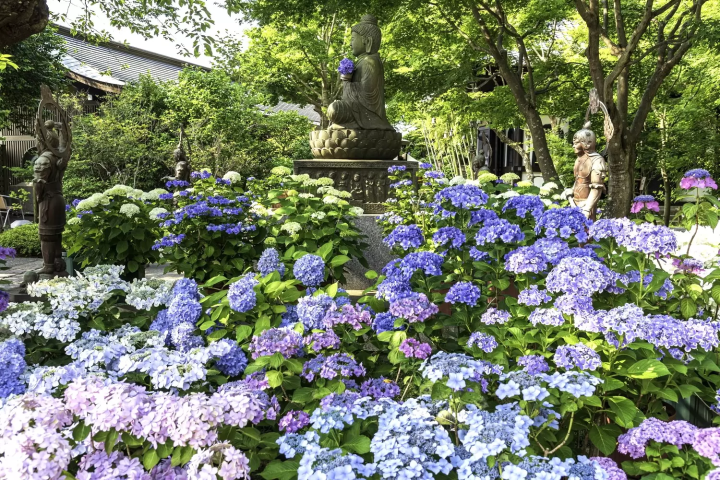
Photo by Pixta
Hasedera Temple was established in 736 AD. Its official name is Kaikozan Jishoin Hasedera, a temple of the Jodo sect.
Buildings like the Kannondo Hall are built on a hill overlooking the ocean. Visitors can enjoy the breeze from Sagami Bay here.
While this temple is famous for the Eleven-headed Kannon, its guardian deity, it is also known for flowers.
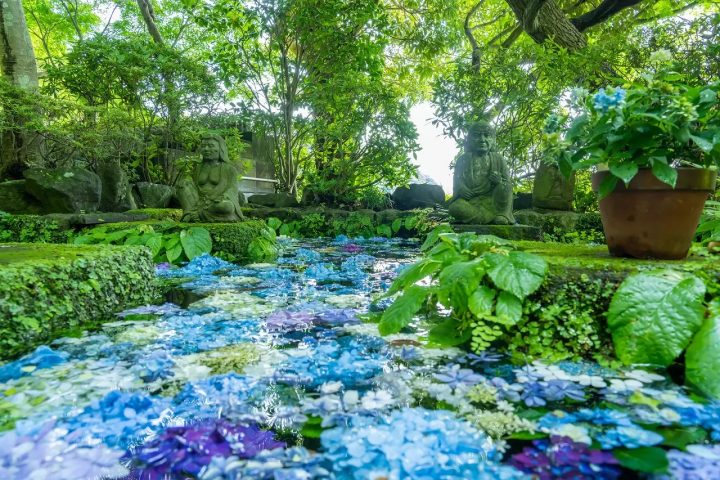
Purification fountain decorated with hydrangeas. Photo by Pixta
There are more than 40 types of hydrangea, 2,500 in all, which draws many visitors during the season.
Along with a ticket to enter the temple, a hydrangea ticket is also required to view the seasonal flowers. A dated and timed ticket is available on the official website, so be sure to check it out!
Comment from a Kamakura Local
The temple is famous for its hydrangea, and numbered tickets will be handed out if the grounds become crowded.
Hasedera Temple
Address: Kanagawa, Kamakura, Hase 3-11-2
Visiting allowed from 8:00 to 17:00, during the special viewing period from April to May.
Admission: 400 yen (Adults)
Official Website: https://www.hasedera.jp/en/
2. Kosokuji Temple
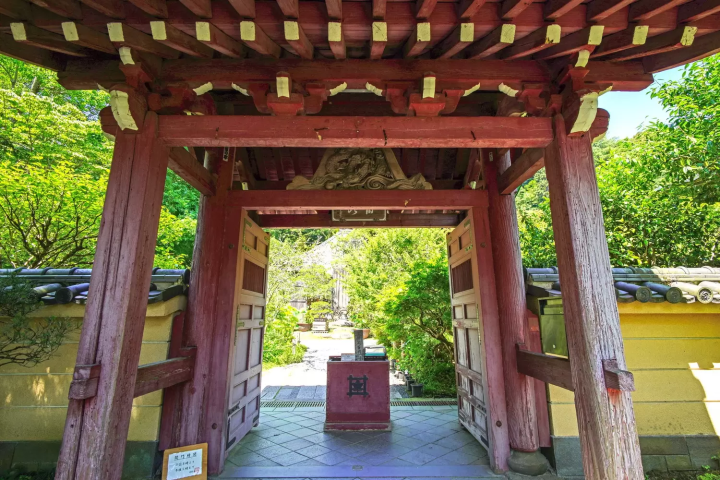
Photo by Pixta
Kosokuji Temple is another spot famous for its flowers. It is a temple of the Nichiren sect established in 1260 by a Nichiren disciple under Hojo Tokiyori's government.
Cherry trees by the gate and Aronia shrubs near the main hall create different scenery depending on the season.
During the rainy season, more than 200 hydrangeas, collected from all over Japan, will greet visitors.
Comment from a Kamakura Local
This temple, which has a serene atmosphere, features many flowers, including hydrangea serrata (tea-of-heaven).
Kosokuji Temple
Address: Kanagawa, Kamakura, Hase 3-9-7
Visiting allowed from 8:00 to 17:00
Admission: 100 yen (Adults)
3. Goryo Shrine
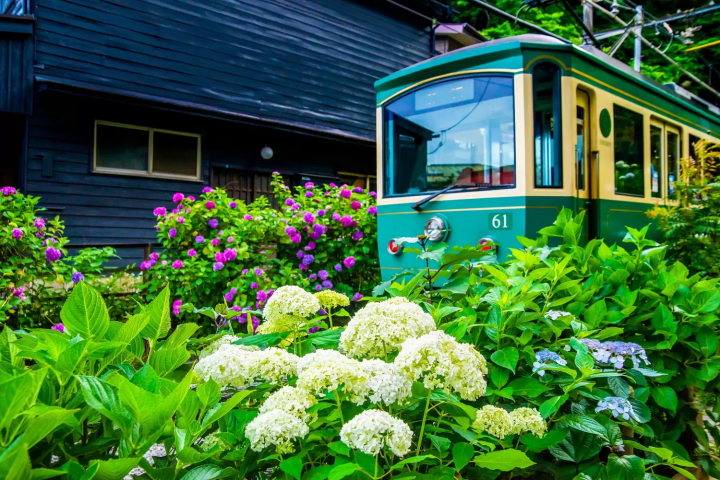
Photo by Pixta
Goryo Shrine is designated as a Japan Heritage Site. It is also called Gongoro-sama by locals.
Gongoro-sama was a samurai in the late Heian Period (794-1185), a descendant of the Taira clan, also known as Kamakura Kagemasa. In Kabuki, successive generations of Ichikawa Danjuro portrayed Kagemasa.
The shrine, which hosts a unique festival in summer, is also known for hydrangeas. There used to be flowers near the tracks of the Enoshima Electric Railway. However, as of 2024, it seems that some of them were pruned.
Taking photographs is prohibited on the grounds. Also, photographing too close to the tracks may bother the neighboring residents, so be careful.
Comment from a Kamakura Local
The temple used to be famous for the Enoshima Electric Railway and hydrangea, but the flowers near the tracks seem to have been pruned. Maybe there will be potted plants during the season.
Goryo Shrine
Address: Kanagawa, Kamakura, Sakanoshita 4-9
Visiting allowed from 9:00 to 17:00
Admission: 100 yen (Adults)
4. Gokurakuji Temple
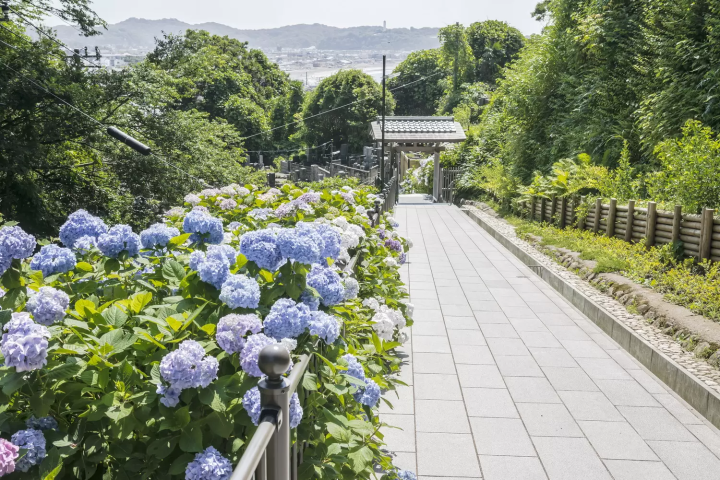
Photo by Pixta
Gokurakuji Temple was established in the Kamakura Period (1185-1333), around the time when Japan was attacked by the Yuan dynasty, to pray for the country's security.
Founded by Ninsho, the temple's original objective was to care for the poor and the sick. There is a pot at Gokurakuji Temple that was used to grind ingredients to make medicine.
Hortensia is the main flower at this temple. The exported Japanese hydrangea was selectively bred overseas and imported as Hortensia.
There is also a cafe with a view of the flowers, where visitors can take a break.
Comment from a Kamakura Local
The hydrangea flowers by the gate are truly beautiful.
Gokurakuji Temple
Address: Kanagawa, Kamakura, Gokurakuji 3-6-7
Visiting allowed from 9:00 to 16:30
Admission: Voluntary donation
Near Kamakura Station
The area around Kamakura Station, where the JR Yokosuka Line and Enoshima Electric railway stop, offers many places to enjoy hydrangeas.
While some temples are located from the station, walking by Wakamiya-oji, Komachi-dori, and Tsurugaoka Hachimangu Shrine along the way might be fun.
5. Myohonji Temple
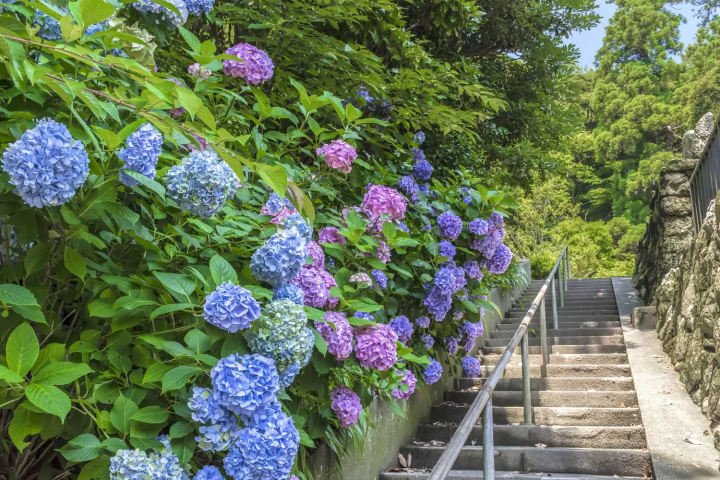
Photo by Pixta
Myohonji Temple is associated with the Hiki clan, as depicted in the TV drama "The 13 Lords of the Shogun."
The Aronia shrubs planted by the gate have become famous, as the flower was adored by the poet Chuya Nakahara and the author Hideo Kobayashi of the Showa Period.
From Kamakura Station, it is a 10-minute walk to Myohonji Temple, where visitors can watch fireflies in early summer. This is an ideal retreat from the bustle around the station.
Tea-of-heaven and lace-cap hydrangeas are planted at the temple. While the total number is not certain, the large flowers along the approach are awe-inspiring.
Comment from a Kamakura Local
Even though there is a small crowd during the hydrangea season, this temple has a serene aura.
Myohonji Temple
Address: Kanagawa, Kamakura, Omachi 1-15-1
Visiting allowed from 10:00 to 16:00
Admission: Voluntary donation
Official Website/https://www.myohonji.or.jp/english/
6. Myohoji Temple
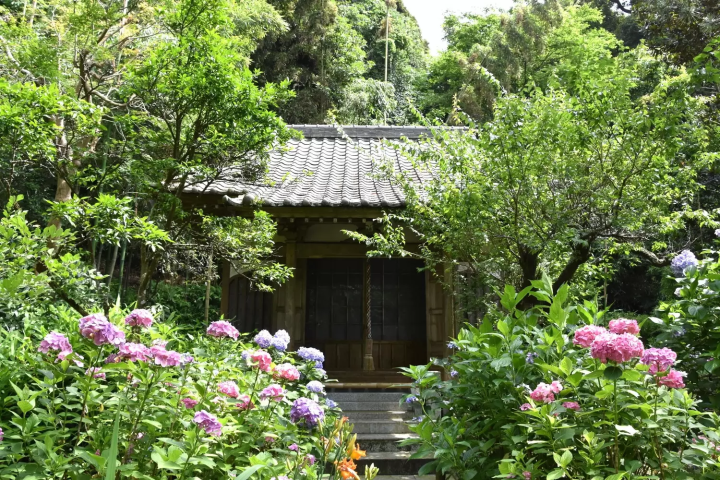
Photo by Pixta
The grounds of Myohoji Temple are covered by moss, which is why it's known as Kokedera (Moss Temple).
The temple, established in the Muromachi Period (1336-1572), became popular in the Edo Period. There were donations from Hosokawa and Mito clans, and Myohoji Temple was frequented by the members of Oh-oku (women's quarters of Edo Castle).
There are over 50 hydrangeas at this verdant temple.
Please note that taking photographs is prohibited at Myohoji Temple. Visitor hours are also restricted to the first and second weeks of the month in the spring/summer season (from mid-March to July) and the autumn/winter season (from mid-September to December).
Comment from a Kamakura Local
The temple grounds have a soothing effect. The moss along the stone steps looks especially beautiful when hydrangeas are in full bloom.
Myohoji Temple
Address: Kanagawa, Kamakura, Omachi 4-7-4
Visiting allowed from 9:30 to 16:30
Admission: 300 yen (Adults)
7. Ichijo Ekan Sanso
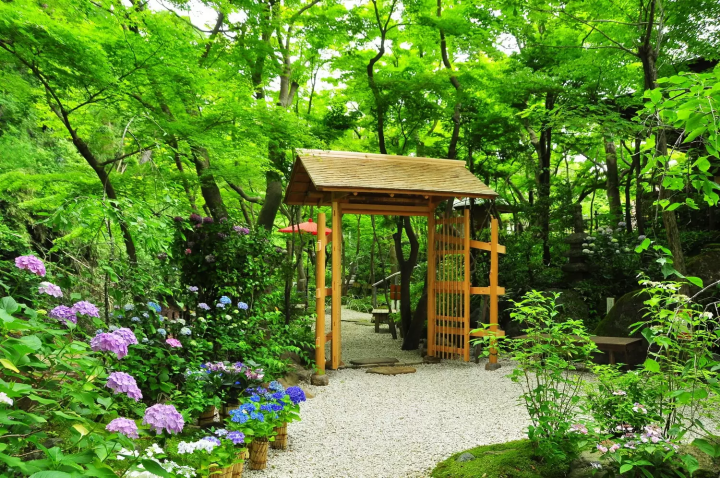
Photo by Pixta
Formerly owned by Ichijo Ekan, this building was relocated from Kyoto to the current site.
It may look like a rural house with a thatched roof, but the building has ties with the imperial family. The interior is decorated in a delicate, aristocratic fashion.
At Cafe Yamamomo-tei, located on-site, visitors can enjoy tea while viewing the garden. In 2023, the cafe served hydrangea juice made with butterfly pea.
While Ichijo Ekan Sanso does not have many hydrangeas, some of the flowers are arranged on the surface of a water basin, which highlights the exterior of the building.
Comment from a Kamakura Local
Tea-of-heaven hydrangeas are planted in the lovely garden. Visitors can walk to the Nameri River from the grounds.
Ichijo Ekan Sanso
Address: Kanagawa, Kamakura, Jomyoji 5-1-10
Visiting allowed from 10:00 to 16:00
Admission: 500 yen (Adults/Children)
Official Website: https://ekan-sanso.jp/
Near Kita-Kamakura Station
From Kamakura Station, Kita-Kamakura is the next stop along the JR Yokosuka Line.
The JR line passes through the grounds of Engakuji Temple, which is a unique situation. There are many temples in this area, along with roads perfect for a stroll.
8. Engakuji Temple
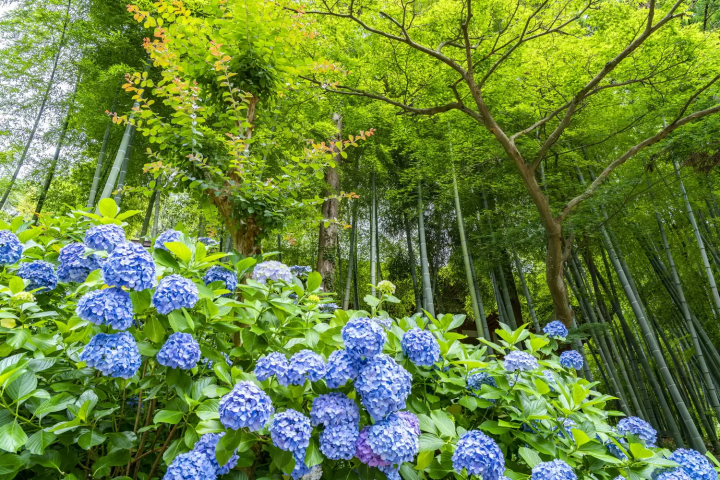
Photo by Pixta
The Engakuji Temple grounds, located in a valley, are large enough for the JR Yokosuka Line to pass through.
Engakuji is a temple of the Rinzai school of Zen Buddhism and visitors can experience shakyo (hand-copying of sutras).
Hydrangeas are planted from the temple gate to around the grounds.
Please note that monopods and tripods for cameras are prohibited at Engakuji Temple, and sketching is also not allowed.
Comment from a Kamakura Local
Hydrangeas can be seen all over the vast grounds.
Engakuji Temple
Address: Kanagawa, Kamakura, Yamanouchi 409
Visiting allowed from 8:30 to 16:30
Admission: 500 yen (Adults)
Official Website: https://www.engakuji.or.jp/en/
9. Meigetsuin Temple

Photo by Pixta
Meigetsuin Temple is famous for hydrangeas, just like Hasedera, with several thousand flowers on the grounds. The soil plays a significant role in creating Meigetsuin Blue, the unique color of these seasonal flowers.
Tourists from across Japan visit the temple to view the hydrangeas on both sides of the approach. The line of people sometimes stretches all the way to Kita-Kamakura Station.
Meigetsuin Temple was originally established to hold a service for those who died in the Genpei War (1180-1185). The temple houses the wooden statue of General Uesugi Shigefusa, an essential cultural asset designated by the Japanese government. The grounds are also designated as a historic site.
Comment from a Kamakura Local
Since the temple is crowded, photographing only flowers will be difficult. The gate sometimes opens early, so it would be best to visit early in the morning.
Meigetsuin Temple
Address: Kanagawa, Kamakura, Yamanouchi 189
Visiting allowed from 9:00 to 16:00 (The time is subject to change during the hydrangea season.)
Admission/500 yen (High school students and over.)
Read also
10. Tokeiji Temple
Since the Kamakura Period, Tokeiji Temple has been known as an enkiri-dera, which functioned as a safe house for women seeking divorce.
Tokeiji is now a temple where visitors can enjoy the flowers and various cultural assets such as Buddha statues, paintings, calligraphic works, and lacquer works.
Tokeiji Temple is located in a yato (steep valley) filled with hydrangeas, irises, and silver-lace vines, which add a divine aura to the grounds.
Please note that taking photographs on the grounds is prohibited. The temple hopes that visitors appreciate the scenery with their own eyes.
Comment from a Kamakura Local
The hydrangeas and irises complement each other very well. Iwa-tabako and silver-lace vine will also bloom during this season.
Tokeiji Temple
Address: Kanagawa, Kamakura, Yamanouchi 1367
Visiting allowed From/9:00 to 16:00
Admission: Free. Please note that the visitors are asked to worship the guardian deity and make a monetary offering.
Official Website: https://tokeiji.com/
11. Kenchoji Temple

Photo by Pixta
Kenchoji Temple is a temple of the Rinzai sect and is also known as the birthplace of kenchin-jiru (Japanese vegetable soup). On the grounds, visitors can try zazen (Zen meditation), shakyo, and go-eika (Buddhist pilgrim's hymn).
The vast grounds house a collection of national treasures and important cultural assets alongside the hydrangeas.
The ten-en hiking course, where trekkers can enjoy different scenery every season, is also nearby. Along the course, there are cherry blossoms in spring and iwa-tabako, a kind of hydrangea, in the summer.
Hortensia, tea-of-heaven, and lace-cap hydrangeas can also be seen on the temple grounds.
Comment from a Kamakura Local
Hydrangea can be viewed everywhere on vast grounds.
Kenchoji Temple
Address: Kanagawa, Kamakura, Yamanouchi 8
Visiting allowed from 8:30 to 16:30
Admission: 500 yen (Adults)
Official Website: https://www.kenchoji.com/
12. Chojuji Temple

Photo by Pixta
Shogun Ashikaga Takauji, who established the Muromachi Shogunate in 1336, founded Chojuji Temple. The temple is across the road from Kenchoji Temple, at the north end of Kamegayatsu-zaka. The hydrangeas along Kamegayatsu-zaka Hill are just as lovely as the flowers on the temple grounds.
Kamegayatsu-zaka is a steep slope, so be sure to wear shoes that are easy to walk in.
Chojuji Temple opens its gate to visitors from spring to early summer (the hydrangea season) and fall to winter (the autumn leaves season).
Comment from a Kamakura Local
Don't miss the hydrangeas along Kamegayatsu-zaka Hill. Be sure to check the days that the temple allows visitors.
Chojuji Temple
Address: Kanagawa, Kamakura, Yamanouchi 1503
Visiting allowed from 10:00 to 15:00 (The temple will be closed on rainy days.)
i. April and May: Open on Fridays, Saturdays, Sundays, and National Holidays.
ii. June: Open from Wednesdays to Sundays.
iii. From October to November 22nd: Open on Fridays, Saturdays, Sundays, and National Holidays.
iv. From November 23rd to December 7th: Open every day.
Admission: 300 yen (Adults)
13. Kuzuharaoka Shrine
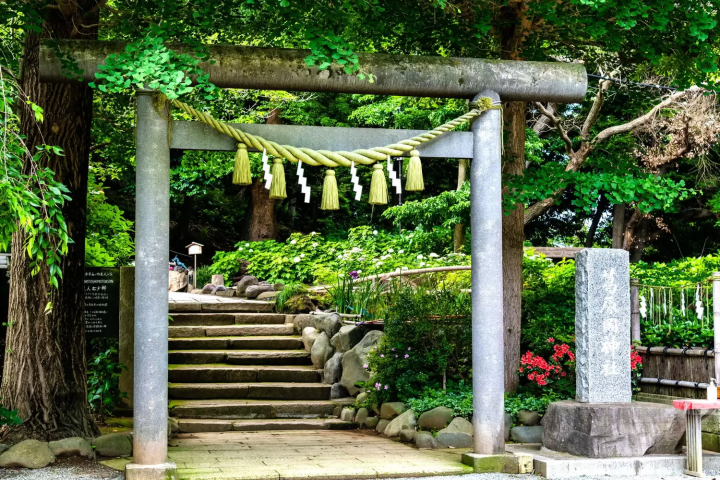
Photo by Pixta
Kuzuharaoka Shrine, famous for its power of matchmaking, is dedicated to the deity Daikokuten.
The shrine's charm, which is said to fulfill one's romantic wishes, is made from cherry shells collected at Kamakura beaches. The adorable, pink-colored item is perfect as a souvenir.
Daikokuten is one of the seven deities of good fortune, and another deity, Benzaiten, is worshipped at a nearby shrine. The two shrines are located at the top of a steep slope. Therefore, visitors will feel like they are climbing a mountain rather than a strenuous trek.
But the view of the hydrangea is well worth the climb. There are 150 types of hydrangea, amounting to 2,700. So please enjoy the scenery and pray for your dreams.
Comment from a Kamakura Local
While the route may be a little vertical, the little-known shrine will not be so crowded.
Kuzuharaoka Shrine
Address: Kanagawa, Kamakura, Kajihara 5-9-1
Visiting allowed from 8:30 to 16:30
Admission: Voluntary donation
Official Website: http://www.kuzuharaoka.jp/
14. Kitakamakura Old Private House Museum
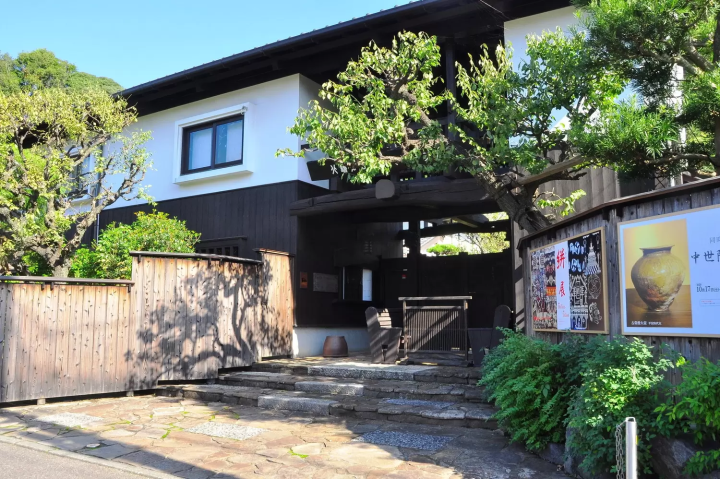
Photo by Pixta
The Kitakamakura Old Private House Museum consists of old houses that were relocated to Kita-Kamakura. The buildings made from zelkova or pine are sturdy, reminding visitors of the heavy snowfall in Fukui Prefecture, where some of the buildings came from.
The facility hosts artist exhibitions and displays of cultural materials such as dolls. Admission fees vary according to the exhibition, so be sure to check before visiting.
More than 100 types of hydrangea can be seen at the museum, including some rare ones.
Comment from a Kamakura Local
Although the museum is close to Kita-Kamakura Station, it's not crowded. They host an exhibition of hydrangeas every year.
Kitakamakura Old Private House Museum
Address: Kanagawa, Kamakura, Yamanouchi 392-1
Business Hours: 9:00 to 18:00
Admission: 500 yen (Adults)
Official Website: https://www.kominka-museum.com/
Other Spots
Besides temples, there are other facilities in Kamakura where visitors can view hydrangeas. It might be fun to walk around and take in the local scenery.
15. Kamakura Seaside Park
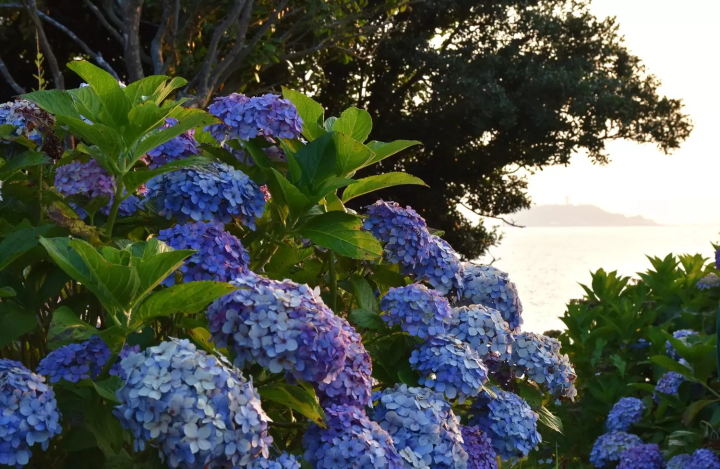
Photo by Pixta
Inamuragasaki is a famous beach between Yuigahama, a swimming beach, and Shichirigahama, a surfing spot. The beach has been chosen among the 100 places in the Kanto region to view Mount Fuji. It is also home to Kamakura Seaside Park.
Hydrangeas are planted in the observation deck, where visitors can enjoy the view of Mount Fuji and Enoshima.
This park greets visitors every season with different types of flowers. Visitors can enjoy the ocean view and seasonal blooms.
Comment from a Kamakura Local
Hydrangeas are also planted at the top of the hill. Mount Fuji can be seen on a clear day, and the view is truly relaxing.
Kamakura Seaside Park
Address: Kanagawa, Kamakura, Inamuragasaki 1-285-1
16. Raitei
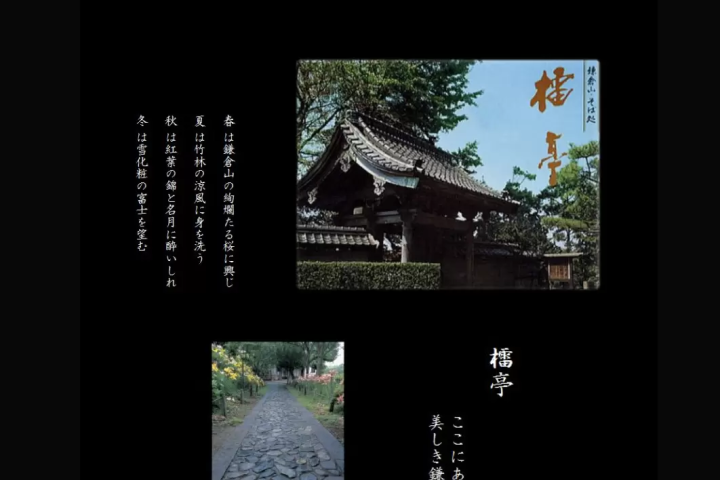
Picture courtesy of Raitei Official Website.
Raitei, located atop a hill, is a Japanese restaurant with a beautiful garden.
The garden features stone Buddha statues and an octagonal hall made in the image of Horyu-ji in Nara. Raitei is a designated Japan Heritage Site and offers a view of Mount Fuji, the Hakone Mountains, and Sagami Bay from the grounds.
Different types of flowers bloom in the garden every season, so visitors can enjoy the scenery alongside delicious cuisine.
Comment from a Kamakura Local
Depending on the season, the promenade garden greets visitors with different flowers, including hydrangeas. The restaurant also serves soba.
Raitei
Address: Kanagawa, Kamakura, Kamakurayama 3-1-1
Business Hours: 11:00 to 20:30
Official Website: https://www.raitei.com/
17. Ofuna Botanical Garden
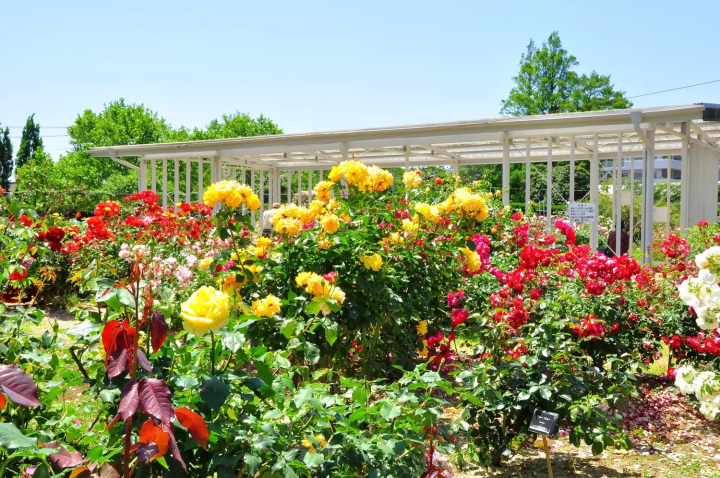
Rose Garden Photo by Pixta
The Ofuna Botanical Garden is managed by Kanagawa Prefecture. Visitors can enjoy the flowers in the lawn garden, greenhouses, and exhibition rooms.
Peonies, roses, irises, and hydrangeas will bloom in early summer. Ofuna Botanical Garden has over 60 varieties of hydrangea, including hortensia, lace-cap hydrangeas, and oakleaf hydrangeas. The facility also hosts an exhibition titled "Autogenous Japanese Hydrangea."
Visitors can enjoy the hydrangeas and gain knowledge as well.
Comment from a Kamakura Local
Since the facility is located away from central Kamakura, it is not a tourist attraction. While the garden may be little known, it is famous among locals, displaying seasonal flowers year-round.
Ofuna Botanical Garden
Address: Kanagawa, Kamakura, Okamoto 1018
Business Hours: 9:00 to 16:30 (Open from March to October.)
Admission: 200 yen (Adults)
Official Website: https://www.fcofuna-kanagawa.jp/
Enjoy Hydrangea Viewing in Kamakura
Hydrangeas can be viewed at temples, by the ocean, and in the nostalgic townscape of Kamakura.
Although located in Yokohama City, Hakkeijima is another place to enjoy these seasonal flowers. Additionally, due to its moderate climate and ample sunshine, there are many places to view hydrangeas in Kanagawa Prefecture.
If you have the chance, look for some colors during the rainy season to see the verdant scenery of Kamakura.
Snap beautiful photos among hydrangeas in a yukata!
Read also
Main image by Pixta


































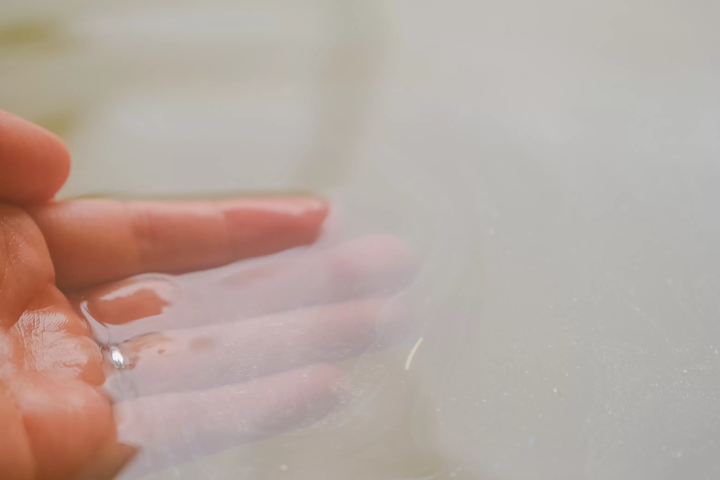


![[Wakayama Guide] Ume and Umeshu (Plum and Plum Wine)](https://resources.matcha-jp.com/resize/720x2000/2025/12/08-252248.webp)
![[2025 Update] From Kansai Airport to Namba - Recommended for travelers with large luggage! Travel comfortably by bus](https://resources.matcha-jp.com/resize/720x2000/2025/10/25-248088.webp)